Donovan R. Walling's Blog, page 5
October 25, 2012
Time for Shakespeare

It seems to be obligatory to set Shakespeare’s plays in some
period other than Shakespeare’s own. I don’t object to this strategy; it’s been
going on for decades if not centuries. But I do occasionally find the results
of juxtaposing the playwright’s poetic 16th-century cadences with modern
settings curious, though often curiously compelling.
Recently the Indiana University production of Richard III set the action in the
ambience of competing motorcycle gangs. (One thinks immediately of West Side Story, the Leonard Bernstein
musical that retells Shakespeare’s Romeo
and Juliet through rival street gangs.) In this case the choice seemed cued
by some analytical remarks by author Josephine Tey, helpfully included in the
program notes:
For thirty years, over this green uncrowded land, the Wars
of the Roses had been fought. But it had been more of a blood feud than a war.
A Montague and Capulet affair; of no great concern to the average Englishman….
It was a small concentrated war; almost a private party.
Biker leathers with clan emblems and embroidered roses—now
universally called Tudor roses—fit the notion of internecine strife, white rose
versus red rose. A modernist and timely touch was the addition of
“fact-checking,” a nod to the current presidential election season in which the
usual political falsities are revealed by various fact-checking organizations.
In this instance a television screen flashed periodic historical corrections
that played against Shakespeare’s Tudor-slanted take on events. Shakespeare’s histories,
in particular those of times and figures most immediate to his own era, were
propagandistic, designed to conform to the views of Elizabeth I, who, like her
father Henry VIII, was not a monarch to be crossed without mortal peril.
All in all, I found the biker motif added rather than
detracted from the essence of the play. The darkness worked for this dark,
brutal, bloody drama in a way similar, but in stark contrast, to the IU
production of The Taming of the Shrew
this past July. That staging set Shakespeare’s boisterous romantic comedy in a
South Beach, Florida, sort of place, which also worked well: a light-hearted
play set in a light-filled locale.

September 11, 2012
Gore Vidal's Box Set

Vidal at 23, photographed by
Carl Van Vechten in 1948
When Gore Vidal died in July at age 86, I belatedly
discovered that he had written three mystery novels in the early 1950s, under
the penname Edgar Box. An inveterate mystery reader, I take particular delight
in discovering mystery novels written by persons best known for other pursuits.
(A favorite example is striptease artist Gypsy Rose Lee, who penned two
mysteries in the early 1940s, the first titled, appropriately, The G-String Murders.)
Gore Vidal, aka Edgar Box, cranked out three mysteries in
quick succession: Death in the Fifth
Position (1952), Death Before Bedtime
(1953), and Death Likes It Hot (1954).
They were reissued in a single volume, titled Three By Box, in 1978. All three feature a reporter-cum-p.r. man,
Peter Sargeant, as the amateur detective. Sargeant is a suave, if sometimes
bumbling, sexual swordsman, almost a comic James Bond without the trappings of
spydom. (Fleming’s 007, however, did not debut until Casino Royale in 1953.)
Despite its heterosexual hero, the first of Vidal/Box’s trio
is an unabashedly gay—in both old and new senses of that word—romp along the
lines of Oscar Wilde meets Raymond Chandler. The novel is a delicious
foreshadowing of later flamboyant works, such as the outrageous Myra Breckinridge (1968), the movie
version of which provided a final screen vehicle for the inimitable but often
imitated Mae West, and the surreal and irreverent Live From Golgotha (1992).
Death in the Fifth
Position is a surprising novel for the early Fifties for its frank, often
gay, sexuality. But the treatment is not so surprising for Vidal, who had
published The City and the Pillar in
1948. That novel offered a coming-of-age story about a young man coming to
terms, healthily, with his homosexuality. Thus it flouted convention, which at
the time regarded gay as synonymous
with immoral, and so caused a
scandal. The City and the Pillar was
only Vidal’s third novel, and one can imagine an editor, on receiving the
manuscript of Death in the Fifth Position
a couple of years later, counseling the author to adopt a pseudonym for the
latter book’s publication. I don’t know whether that happened, but I wouldn’t
be surprised if it did. Of course, it could equally be the case of a “serious”
writer not wanting to be associated with something as déclassé as a mystery
novel.
By contrast, the second of the trio, Death Before Bedtime, is sadly pedestrian. It is a serviceable
mystery but lacks punch and pizzazz. The third, Death Likes It Hot, regains some sparkle, rather like a second wind
along about midnight after an evening of hard partying. But it doesn’t measure
up to the first mystery either, and I’m inclined to think that Vidal must have
felt as though, after this third effort, he had gotten mystery writing out of
his system. Box was laid to rest.
Still, the three novels are entertaining and, as mysteries
go, intriguing. They are worth taking up, though no one could be faulted for
stopping after the first one.

August 21, 2012
Twenty-One
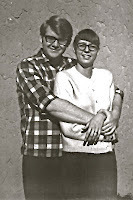
In 1989 my wife Diana and I had been married twenty-one
years. We had met in high school and wed at age twenty. After two decades we
had grown to a family of five with the addition of three children: a daughter
in 1970, a son in 1976, and another son in 1987.
As part of our anniversary
celebration I crafted a poem. It is so minimal as to be almost in code, but the
chronology was ours. It was our own not-so-secret itinerary of twenty-one
years.
Twenty-One
Two. One.
San Antonio,
Where we sketched the melody.
Who would have guessed?
Then? Emporia.
Now we are one.
Two. One.
Two in step.
A kind of dance, just we
Two.
Three. Four.
And then five. Amazing!
Sheboygan.
Amazing Zweibrücken.
Twenty-one years, stepping
In time.
Who would believe it?
I can give you a lyric.
The rhyme is clear too.
But I own no rhythm:
The rhythm is you.
Two years later, in 1991, Diana died during an asthma
attack. A lifelong medical condition had suddenly turned vicious.
On August 22, 2012, another twenty-one years will have
passed. It will be a sadder anniversary, marking the event of her death. In two
decades I have moved on with my life, as one must. But I have never forgotten
the two decades of joy Diana and I had together.
Twenty-One, Again
Two. One.
A decade, then another,
And one more year.
Who would have guessed?
Then? Well, that was
When the world ended,
Came crashing down.
Two became One.
Dance halted, music stopped.
And then—one life went on.
Twenty-one years, again,
Raced by.
Who would believe it?
Yet my empty arms
Still hold you,
And my aching heart
Still loves you.
Twenty-one then, twenty-one now,
But never time enough.

August 6, 2012
Singing Together
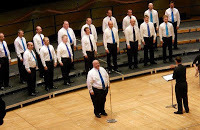 Ten years ago my partner, Sam Troxal, conceived the idea to
Ten years ago my partner, Sam Troxal, conceived the idea tostart a men’s chorus in Bloomington, Indiana. This year the resulting
Quarryland Men’s Chorus celebrated its tenth season by premiering a
commissioned work, Will and Testament,
by composer Greg Gilpin, at its spring concert at First United Church. The
chorus followed that with its first-ever performance at the GALA Choruses
Festival 2012 in Denver, Colorado, in July. The new commission was part of
their festival set. A clip from Will and Testament, sung at the sendoff concert in June, can be heard on YouTube,
along with other tidbits of performances and rehearsals.
GALA was a signature event for the ten-year-old chorus. More
than six thousand performers and others from more than 250 gay, lesbian, and
ally choruses crowded into the mile-high city for four and a half days of sheer
magic—the magic of singing together. Choruses ranged from a handful of singers
to well over a hundred voices. Overlapping strands in three, sometimes four, concert
halls made it impossible to hear every chorus. But the sounds were incredible,
by turns funny and moving.
The power of communal song was never more evident than in
this gathering—not a competition, but a celebration. A celebration of our
collective strength as gay men and lesbians and our friends, our collective
voices as singers and supporters, and our collective humanity, having gathered
for the most positive of all artistic endeavors: singing together.
Personally, one of the most moving and energizing aspects of
the festival was the inclusion of youth choruses. Some forty years ago, when I
was a beginning teacher in a Wisconsin junior high school, we used to troop all of the students into the auditorium from time to time for what we referred to as a
“community sing.” It was an opportunity for students to learn proper audience
behavior, of course. But most of all it was an opportunity for all of
us—students, teachers, and administrators—to sing together.
This occurred before the assault on the arts began to rob
schools of art, music, and theater programs; before the energy crisis led to
the disastrous decision to convert the school’s WPA-era auditorium into a
cafeteria; before the more recent ill-conceived advance of test, test, test
ideology that today overwhelms and often edges out good teaching in all subjects and the arts writ large, in particular.
Recently I glimpsed that positive power of communal singing in a group I
discovered on YouTube: Only Boys Aloud. This 133-voice chorus composed of Welsh
lads, ages 14 to 19, is mind-blowingly inspiring. One can only hope that educators here, across the United States, can rediscover the positive power for community building, cooperation, collaboration, and learning of singing together.

June 19, 2012
Walking Wounded
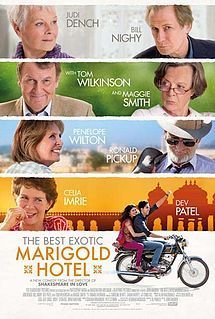 A couple of weeks ago my partner, Sam, and I saw the movie, The Best Exotic Marigold Hotel, starring
A couple of weeks ago my partner, Sam, and I saw the movie, The Best Exotic Marigold Hotel, starringa clutch of senior Brit actors—Maggie Smith, Judi Dench, Tom Wilkinson, Bill
Nighy, and others—and the younger, charming Dev Patel. The story is about a
group of British elders who decide to “outsource” their retirement and move to
a hotel haven in India, only to find on their arrival that the haven is a
hovel.
The film is a delight. It tugs at the heartstrings and
tickles the funny bone, and, all in all, gives viewers a chance to see some of
the best older actors around do their thing. The aging actors are resplendently
wrinkled. Sam turned to me afterward and asked, “Didn’t they put any makeup on
them?” It did make us wonder.
Perhaps it was seeing this movie that made my own age come home
all the more in those moments when one looks in the mirror and wonders who
might that be looking back. I’m still not quite a senior citizen—at least, not
all the time. But I’m not far off.
Sitting in a coffee shop today, I became aware of an older
woman passing by the window on her way in. Gray haired, probably in her
seventies, she was still sprightly, dressed in rolled up khaki shorts. I
noticed that her athletic shoes had been split in the back to accommodate
braces on both ankles. The shoes and the braces, the shorts, not caring who
noticed, all bespoke a certain indomitable spirit.
Seeing her inspired the poem that I jotted down once I got
home. Perhaps it will strike a chord, particularly with my older readers.
Walking Wounded
We are the walking wounded,
Limping, bodies bent under years,
Torn pages from calendars, torn up,
Tossed like confetti. We celebrate
The wear and tear on joints
Used for running and jumping,
The wrinkles around eyes and mouths
From laughing at life, at ourselves.
I get the senior discount, sip coffee
Over old news and new stories,
Savor my small-portion banquets
And turn in early to wake even earlier.
I prize clear mornings and foggy mirrors,
Moments when I remember names.
We are walking, wounded, oh yes,
But we are walking all the same.

May 10, 2012
Rubbing Musical Elbows

My musical talent, as the saying goes, would fit into a thimble with
room left over for three raisins and a caraway seed. Consequently, I am in awe
of those who make music, whether as composers or performers. In Bloomington,
Indiana, where we have the renowned Indiana University Jacobs School of Music,
you can’t throw a paper airplane without hitting an accomplished musician.
This means that ordinary folk like me get to rub elbows with some
fascinating and accomplished individuals, whether it’s running into (not
literally, thankfully) jazz and classical composer, conductor, and teacher
David Baker on the jogging track at the local YMCA, being greeted at a
reception by opera soprano Sylvia McNair, sharing lemonade and munchies with young
harpists in the home of Susann McDonald, founder of the USA International Harp
Competition, or enjoying a pitch-in dinner with music scholar and authority on
the American composer Charles Ives, Peter Burkholder—and those are just four of
the faculty. I did a double-take not long ago when I noticed that the
keyboardist in a local rock cover band, playing a pizza joint-cum-music club
that evening, was a well-known classical organist and IU professor that I’d
last seen performing Bach in a much different setting.
But it’s the students that really awe me. The tenor or the soprano
who’s soloing in our church choir not unusually can also be spotted in an opera
on campus or a musical play somewhere in town, or may well be headlining at a
local jazz club.
A recent acquaintance has been Texu Kim, an unassuming graduate
student from Seoul, Korea. Tex, as he’s called, is doing doctoral studies in
music composition at the Jacobs School. He’s so modest and unassuming that it
took me several conversations to realize that this young composer is already
amazingly accomplished. This past academic year alone he has flown to Paris and
Frankfurt for premieres of his compositions.
In Paris this past January, the Ensemble
Intercontemporain, directed by Finnish conductor Susanna Mälkki, performed his “Toccata
Inquieta,” a work for solo harpsichord and ensemble. The harpsichordist was
Dimitri Vassilakis. The concert also was broadcast in Germany on
Deutschlandradio Kultur.
In an interview in Paris Tex cited
influences from music played in Korean Christian churches, jazz, and rock, in
addition to classical music. Tex studied chemistry before turning to music
composition, and so he also tends to use mathematical and scientific principles
as tools for musical composition.
In March the Paris premiere was
followed by another in Frankfurt. This time the work was “Sketches for
Contredanse,” with Peter Rundel directing the Ensemble Modern. The composition
was included in a program with several other premieres in the Mozart Hall of
the Alte Oper, or Old Opera (photo). Founded in 1980, the Ensemble Modern is one of the world’s leading
ensembles of Contemporary Music. Currently, the ensemble is composed of
musicians from Argentina, Bulgaria, Germany, India, Israel, Japan, Poland, and
Switzerland.
For someone who’s “just” a grad student, Tex is well on his
professional career path and doing splendidly.
Texu Kim is an outstanding example, but in Bloomington he’s also in
good company. There aren’t many Midwest college towns in which the guy waiting
on your table at a local restaurant could well be singing at the Met next year.

April 27, 2012
A Dame at a Dig
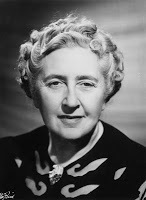
Come, Tell Me How You
Live is so little known among the works of Agatha Christie that it
sometimes is omitted from her bibliography. The book, subtitled “An
Archaelogical Memoir,” was written under her married name, Agatha Christie
Mallowan and published in 1946.
Agatha (nee Miller) Christie married Max Mallowan in 1930,
having divorced her first husband, Archibald Christie, in 1928 after fourteen
years of marriage. Mallowan was an established archeologist; however, his
wife’s fame—though she would not be Dame Agatha until 1971, after her husband
had been knighted in 1968—had already eclipsed his. By the time of their
marriage, Christie had already published several novels, her first in 1920
being The Mysterious Affair at Styles.
This mystery novel featured the first appearance of Hercule Poirot, her longest
running detective. Styles, incidentally, was the name of the Christies’ house
in Sunningdale, Berkshire.
Eventually, Agatha Christie would become the best-selling
novelist of all time, her books selling approximately four billion copies in
more than one hundred languages. Her play, The
Mousetrap, famously, has been in constant production since its premier in
1952. She has been outsold only by the Bible and Shakespeare.
Come, Tell Me How You
Live makes a delightful departure—as it must have been for Christie
herself. It is a rambling, day-to-day memoir that recounts several seasons of
archeological digs in the Middle East during the 1930s, prior to the Second
World War. Reading it gives one some insight not only into the goings on of a
dig in that period but into the character of Christie that in various ways
becomes manifest in the array of personalities in her novels. This is a very
human, interesting and interested individual, who pays attention to both the
vast and the minute. And she’s funny! This memoir is truly entertaining to the
point of chuckling aloud from time to time. So many memoirs take themselves far
too seriously, and this one doesn’t fall into that trap.
Christie’s prewar Middle East digs provided fodder for
several of her popular mysteries, including Murder
in Mesopotamia (1936) and Death on
the Nile (1937). When the war began, the digs ended and Christies set aside
the memoir. In 1944 she took it up again, saying,
But now, after four years of war, I have found my thoughts
turning more and more to those days spent in Syria, and at last I have felt
impelled to get out my notes and rough diaries and complete what I had begun
and laid aside. For it seems to me that it is good to remember that there were
such days and such places, and that at this very minute my little hill of
marigolds is in their bloom, and old men with white beards trudging behind
their donkeys may not even know there is a war.
Readers today are the richer for Christie having taken up the
memoir she laid aside before the war. And we can see, through her keen eyes,
into a world that has, unfortunately, been largely lost forever.

March 17, 2012
Naked Still, Part 2

Back to Sendak's In the Night Kitchen: Child nudity—a state of undress many toddlers prefer, often to the dismay of their parents—is salacious only in a mind driven by perversity. However, in the topsy-turvy view of social-religious conservatism there is no such thing as innocence, except when claimed by those already patently guilty.
Larry Craig, who was caught literally with his pants down engaging in overtly gay sexual behavior, stridently claimed not to be gay. In his own mind, he might not label himself "gay," but that seems to be splitting hairs.
It has become a cliché that the most vociferous anti-gay politicians and pundits will, at some point, be revealed to be deeply closeted, self-loathingly gay. And those who beat the drum of "family values" most loudly seem invariably to be sleeping around or hiring prostitutes.
Many people in the United States, certainly not only conservatives, are deeply afraid of sex and sexuality. Conservatism merely captures this fear (and others) and raises it to a political art form. As Mrs. Reagan was promoting "Just Say No" to sex and drugs, her husband President Reagan was busy ignoring the AIDS crisis—for six years. (AIDS was first reported in the press in 1981; Reagan didn't use the word until 1987.) Recently Texas Governor Rick Perry was stumped when trying to defend the state's just-say-no abstinence sex "education" program in the face of the state's rank as third-highest in teen pregnancies.
Secrecy, silence, fear, and denial. This is "good" and "proper"—and pervasive—in conservative speak. It's topsy-turvy language, just the way that Pro-Life is code for anti-abortion (though scratch a pro-lifer and you'll probably also find a supporter of the death penalty, which would be Pro-Death, wouldn't it?). And, of course, Pro-Choice equates, in topsy-turvy speak, to pro-abortion. In fact, most Pro-Choice proponents are anti-abortion; they just want women to be able to make their own choices about their bodies.
Because social-religious conservatives are fearful about their own sexuality and so often, it seems, desperate to keep their unacknowledged proclivities secret, they espouse a philosophy that everyone should toe the same imaginary line. Thus when their political power is in the ascendency, we get all sorts of repressive laws regarding sex, sexual expression, and sexuality. Don't Ask, Don't Tell, which punished military personnel if they were open about their homosexuality, is one example.
DADT was put into law in 1993, and it took nearly twenty years to overturn it in 2011. The conservative military brass hemmed and hawed, delaying the law's demise as long as possible until it became all too obvious that claims of allowing openly gay service members would undermine the military were ill founded. Fear and hiding were, at last, trumped by openness and rationality.
A naked little boy in a children's illustrated fantasy harms no one. Indeed, it does the opposite. It demonstrates that the innocence of childhood still exists, that nudity does not equate to sexuality or perversion, and that occasionally being naked is not a big deal.
What parent of a toddler hasn't at some point turned around to find that the child has magically shed all of his or her clothes and is running around buck-naked? That's not an occasion for scandal. It should provoke a smile or a giggle—and a resigned chase to get the kid back in some pants.
Making "innocence" into "perversion" is topsy-turvy language. Such nonsense is both silly and dangerous.
(Photo: The image above of a gay Marine jumping into the arms and kissing his boyfriend on returning home went viral on Facebook earlier this year.)

Naked, Part 1
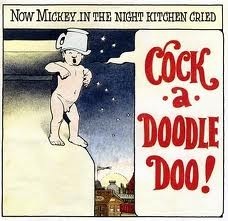
The other day I was reading the free local arts magazine and came upon an article about a local parent challenging one of the public elementary schools over having Maurice Sendak's In the Night Kitchen in their library. This children's book by the well-known and award-winning author-illustrator was published in 1970 and won the prestigious Caldecott Honor in 1971.
The book has been challenged by social-religious conservatives since its publication, most often on the basis of the illustrations, some of which depict the central character, Mickey (right), a boy about three or four years old, naked—and anatomically correct. In the course of the story, Mickey dreams that he hears a noise below him, on the first floor of the house. He floats out of bed and down to the "night kitchen," losing his bedclothes in the process. The bakers in the kitchen, who all look like Oliver Hardy, need milk for the "morning cake," and Mickey resolves to get some for them. He finds a giant milk bottle, which he falls into but eventually delivers to the bakers. Then he crows like a rooster, slides down the bottle, and is magically returned to his bed. This is a perfectly innocent dream story, right?
However, conservatives' prurient interests apparently are aroused by children's nudity, which is hardly surprising but awfully silly. In other cultures, young children can routinely be seen unclothed in parks and on public beaches. It's normal and natural. But not in the United States, where perversion apparently lurks everywhere—and is nowhere more prevalent than in the conservative mind. This is the same mindset that produced the failed "Just Say No" philosophy in place of actual sex education.
Again, this is not surprising considering the number of prominent sex scandals in which conservatives have been involved. In the topsy-turvy, Alice-in-Wonderland world of conservatism, where words often mean the opposite of their true meaning (Fox's "fair and balanced" being neither, of course), sex is hidden, desire is denied, and everyone pretends to saintliness, even after they're caught with their pants around their ankles. Let's look at a few examples:
In 2002 the darling of 9/11, New York Mayor Rudi Giuliani, made headlines with his mistress Judith Nathan (to the consternation of his wife) and carried on quite openly, even providing Nathan with a city car and a police driver to act as her chauffeur.
In 2004 Republican Jack Ryan dropped out of the Illinois senate race (against Barack Obama) because his wife complained openly that he took her to sex clubs and made her have sex with other patrons.
In 2006 Republican Mark Foley, who introduced a bill to outlaw websites with suggestive images of preteen children, was caught sending sexually explicit emails to underage male House pages.
In 2007 Republican Larry Craig, the gay marriage opponent who had famously called President Bill Clinton "a naughty boy" over Clinton's tryst with Monica Lewinsky, was arrested for lewd conduct with another man in a Minneapolis airport restroom.
Well, the list does go on and on, but the implications are clear. When you've set your own hair on fire as many times as conservatives have, it's hard to see a whiff of smoke without envisioning a blazing inferno—indeed, the fires of Hell.
So, of course, innocence never is innocent. Topsy-turvy. More in Part 2.

March 7, 2012
Rambling in Early March

A walk in the woods yesterday prompted me to craft a poem, something I rarely do nowadays. In younger days I wrote more poems, before work and life seemed to get too busy for inspiration to squeeze in. Then, like any trade unpracticed, both skill and impetus simply diminished. But now and then I try to recapture the practice and set down an image or an idea. This was one of those moments.
Listening to Trees
What passed for winter could not resist
The wooded warmth today as I walked
Uphill and then across the ridge as though
It was already spring and not early March.
Fall's littered leaves clung, like tattered paper,
To branches, fluttering in the winsome wind
Like early butterflies, harbingers of a green
Haze, the buds soon to be seen as distant mist.
On the tamped mud path I trod alone, almost,
Passed once by a man and his dog, and then
A young runner in red shorts, legs pumping
In time to the ratatatat of slender trunks
Swaying and clacking like claves tuning up.
Spring's gig. A woodpecker laughed up high.
Geese on the lake below hawked the sunlight
That thrilled the deep blue water, their voices
Clear as street vendors in old times, the age
When the oldest trees were saplings, older
Even than I am, now renewed by these woods
Whispering promises of bright tomorrows.
























